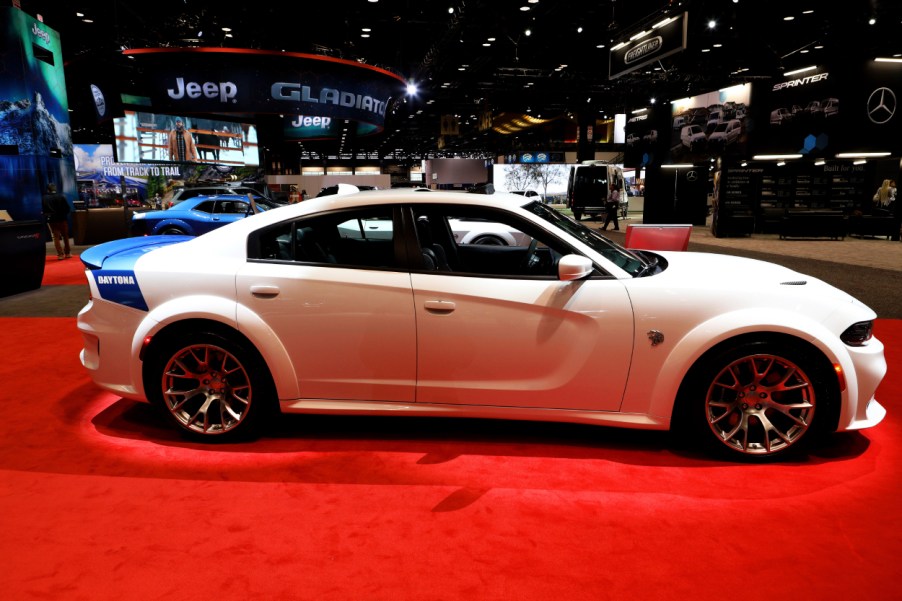
The 2020 Dodge Charger SRT Hellcat Widebody Is Still Stale on the Inside
When the engineers at Fiat Chrysler Automobiles (FCA) were tasked with working on the Hellcat, they strove to build the most powerful Dodge engine to date. The 2020 Dodge Charger SRT Hellcat Widebody underwent extensive development and rigorous testing. Serious engineering was required to ensure its engine didn’t blow up because of the tremendous strain it takes to produce a reliable 707 hp.
Not only were they successful in that respect but it was the largest engine to be fitted in a muscle car. With these kinds of specs, the Hellcat engine quickly became a respected icon. This tradition continued on with the 2020 Dodge Charger SRT Hellcat Widebody. All this focus on the engine might explain why some feel the interior of the car feels a little stale.
The 2020 Dodge Charger SRT Hellcat Widebody is a beast by almost any measure

It goes without saying that the 2020 Dodge Charger SRT Hellcat Widebody is an awesome machine. However, CNET recently published an even-handed review about the 2020 SRT Hellcat Widebody pointing out some pros and cons based on a test-drive conducted by off-road racer Emme Hall.
The Charger SRT Hellcat was designed for performance; it’s ready to be raced around the track, dragged down the strip, or drifted through the turns. Four distinct drive modes allow you to adjust the car’s mechanics via an 8.4-inch Uconnect touchscreen.
Drivers can custom tailor settings such as suspension, traction, paddle shifters, steering effort, horsepower, and transmission shift speeds. The selectable SRT Drive Modes include Auto (sporty but compliant), Sport (firm for maximum handling), Track (firm, maximum handling, performance shifting, and gear-holding ability), and Custom (lets you go crazy).
A Brembo brake system comes standard. With two-piece, 15.7-inch front rotors and six-piston front calipers, you can brake on a dime. It also does an outstanding job at heat management and thermal capacity, which prevents your brake pads from wearing out too fast.
Launch Control and Launch Assist functionality come standard, a first for any factory vehicle. Additional drag racing features include Torque Reserve, Line Lock, and SRT Performance Pages for critical vehicle performance data.
The 2020 Dodge Charger SRT Hellcat Widebody’s interior design is a bit stale
The roomy cabin with its straightforward layout and clearly marked controls are appreciated. The standard trim model is furnished with comfortable front leather-trimmed bucket seats with generous side bolsters.
For a more premium touch, you can get an optional suede headliner with real carbon fiber trim. Being that this is a full-size sedan, the trunk has a decent 16.5 cubic feet of space.
Tech options include Apple CarPlay, Android Auto, a 19-speaker Harman Kardon audio system, a navigation system, and a Wi-Fi hotspot. Plenty of USB and 12-volt outlets are available to both rows of seats.
Nevertheless, the CNET reviewer wrote that the
“Inside is where the Charger is showing its age … the interior design is a bit stale now and there are some budget-rate areas, such as the hollow window controls and flimsy plastic lower door panel compartments.”
A big driver-assistance tech menu is all but nonexistent, with only a “federally mandated backup camera and standard blind-spot monitoring.”
In other words, forget about forward-collision warning, lane-departure warning, and adaptive cruise control.
The V8 powered muscle car is a dying breed
For all intents and purposes, the 2020 Dodge Charger SRT Hellcat Widebody is in a class of its own. No other North American automaker produces a full-size sedan that can compete with the SRT Hellcat straight off the line.
On top of that, Dodge’s two primary domestic competitors are essentially getting out of the muscle car game to focus more on the SUV and crossover markets. Chevrolet is merely decreasing the number of full-size sedans it manufactures while Ford is out of the game completely.
Hopefully, Dodge will continue to produce the Charger SRT Hellcat Widebody long into the future and keep V8 power alive. Even though four cylinders and six cylinders are capable of producing more horsepower than ever before, it still doesn’t feel the same as eight cylinders.


